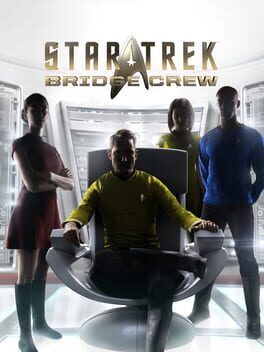

Star Trek: Bridge Crew puts you and your friends in the heart of a starship, where- as officers of the Federation- every action and decision you make together will determine the fate of your ship and crew. Developed specifically for VR, Star Trek: Bridge Crew is the only game to offer a true-to-life level of immersion in the Star Trek universe. In Star Trek: Bridge Crew, the Federation dispatches you and your crew to command the new vessel U.S.S. Aegis as part of a critical initiative. Your mission: explore a largely uncharted sector of space known as The Trench, in hopes of locating a suitable new home world for the decimated Vulcan populace. The Trench contains stunning beauty and undiscovered wonders, but also strange anomalies and dangers yet unknown. The Klingon Empire is also active in the region, and their purpose is undoubtedly a threat to the Federation’s plans. It’s up to you and your crew to chart the sector to determine the Klingons’ aims, and to secure a peaceful Federation presence.
Released on
Genres
Reviews View More
The game itself borrows heavily from Artemis Spaceship Bridge Simulator, a LAN game where you essentially create a starship in your house, with each person having a PC to represent their station (or the viewscreen for the captain). I’ve played it at a convention and it’s a great experience, and Bridge Crew is the closest thing that can be done online.
There are four stations in this game: Captain, Helm, Tactical and Engineering. Captain is the simplest role in multiplayer: you get told the orders to pass on to your crew, answer hails and push the red alert button. Most of this role is via the voice chat, giving commands to your crew (and hoping they pay attention).
Helm gets to fly the ship and set warp and “impulse” destinations (what the game calls in-system warp), and is probably the most involved position due to this.
Tactical gets to control the phaser and shield. There’s no phaser arcs or shield arcs, so unfortunately the combat is very basic. You can disrupt enemy weapons, shields or engines via hacking.
Engineering sets power levels and prioritises repairs, this is probably the worst role to have and you don’t even get a clear idea of what is happening due to not having access to sensor data like the other three roles.
In singleplayer, you play as the captain but can give orders to the crew. The AI is very basic and some actions can reset other orders. The helm officer won’t avoid obstacles, so for some situations, you can take over the station and control it directly (although you can’t give orders from there, you have to return to the Captain’s position). It’s not the ideal way to play, but it gets the job done and is far better than not having the option.
The main (and incredibly short) 6-mission story takes place on the USS Aegis, a ship from the Kelvin timeline. The bridge itself is wonderfully made and fits the aesthetic while adapting it to work for a game like this. The missions are fine, but after this all that’s left is random missions. There’s not a lot of content in this game.
The game does include additional ships you can use in the random missions: the prime timeline original TOS-style Enterprise and (as part of DLC) the Enterprise D. The TOS bridge absolutely looks the part and is very authentic, although you definitely need to use the help overlay to work out which buttons do what. It’s difficult to use, but it gets the feel of being in The Original Series really well.
The Enterprise D bridge takes a few more liberties in its interface, mainly making the LCARS displays more game-like to help it play a lot better. This also makes the engineer’s job (renamed as “operations”) better by improving the repair side of things by assigning damage teams.
Bridge Crew is a great start for a multiplayer Star Trek game, but would have been nice with more in depth gameplay for weapons and shields, as well as far more structured missions.
"oh fuck borg aaaaaaaaaaaaaaaaaa"
